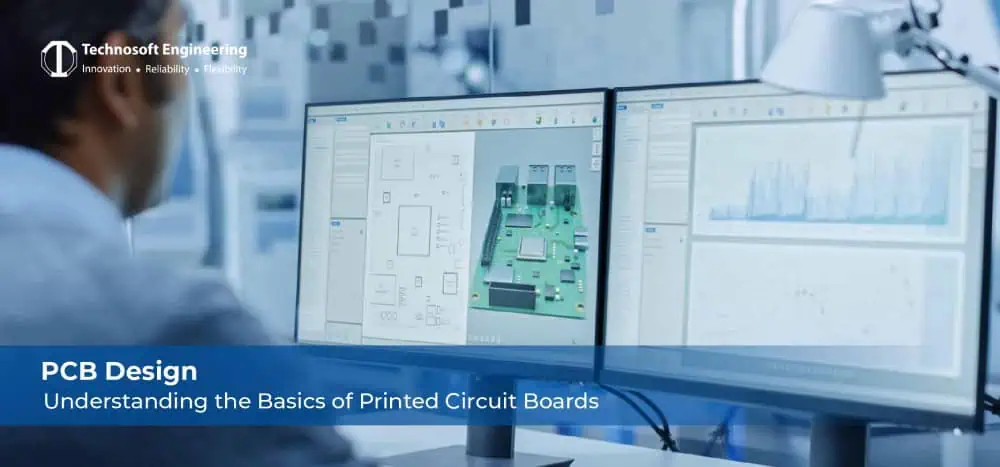
We live in a world of smart devices and connected technology, and electronics are the core of any innovation. Behind every modern device, from your smartphone to industrial machinery, lies an essential element that boosts the entire circuit: The Printed Circuit Board, or PCB.
Suppose you have ever thought, “What is a Printed Circuit Board (PCB)?” or are just about to start with PCB designing basics. In today’s blog, we will provide a detailed introduction, whether you are an engineer, a tech enthusiast, or a business owner looking to create a new product. Understanding the basics of PCB design is essential.
What Is a Printed Circuit Board (PCB)?
A Printed Circuit Board (PCB) is a flat board made from a non-conductive material, usually fiberglass, that holds electronic components. These components are connected through conductive pathways, track, or signal traces that are etched from copper sheets, a flat board made from a non-conductive material, usually fiberglass, that holds electronic components. These components are connected via conductive pathways, tracks, or signal traces that are made from copper sheets. PCBs allow complex electrical circuits to be compactly and efficiently installed inside everything from household gadgets to big medical devices.
PCBs allow complex electrical circuits to be compact and efficiently installed in any household electric gadgets or advanced gadgets. Therefore, without them, electronics would have been bulky, unreliable, and difficult to make.
PCB Design: The Foundation of Modern Electronics
PCB design is the process of creating the layout and structure of a printed circuit board. This process includes both logical design and physical representation (layout) of the board. It’s where engineering, creative thinking, as well as precision come together.
The process is:
- Creating the diagram
- Selecting and placing components
- Routing the traces
- Defining board dimensions
- Preparing files for manufacturing
PCB Layout: Bringing the Design to Life
The PCB layout is one of the crucial stages in the PCB design process. This is where engineers create schematic diagrams in visual format that show how components are going to be placed and interconnected on the physical board.
Good layout practices ensure signal integrity, thermal management, and electromagnetic compatibility. Whereas a poorly laid out board, even with the correct diagram, can fail to perform. That is why printed circuit board layout design is not just technical but it is also strategic.
Types of Printed Circuit Boards
When exploring types of printed circuit boards, it’s essential to know that the design depends on the application. Here are the most common types:
Single-sided PCB:
Components and conductive paths are placed on one side. It is ideal for simple, low-cost electronics.
Double-sided PCB:
These traces are on both sides with connecting layers. Used in more complex connection devices.
Multilayer PCB:
Multiple layers of substrate and conductive material are stacked together. These are found in high-end devices, such as computers and medical equipment.
Rigid PCBs:
These are made from solid materials that don’t bend. Common in fixed-shape devices.
Flexible PCBs:
Made from plastic that bends easily, useful in wearable tech and devices that are foldable
Rigid-flex PCBs:
A combination of strong and flexible parts for devices requiring complex shapes and durability.
Choosing the right type is part of effective PCB circuit designing and is essential to optimize performance as well as the cost.
Basics of PCB Design: What to Know
Understanding the basics of PCB design is essential before you jump into any project. Here are key elements every beginner must consider:
Component Placement:
Always begin with a clear plan. Group related elements and place important ones, like microcontrollers, in centralized areas.
Trace Routing:
Minimize sharp angles and keep traces short in areas where speed is critical. Additionally, optimize return paths to enhance signal integrity.
Power and Ground Planes:
Properly designed power and ground planes drop the noise and boost performance.
Thermal Management:
High-power components require heat sinks or thermal vias to avert overheating.
Design Rule Checks (DRC):
Always make sure to run DRC to make sure spacing and routing rules are met before making it.
Tools and Techniques for Designing Circuit Boards
Modern design circuit board tools make the process effective and accurate. Software, such as Altium Designer, Eagle, and OrCAD, offers simulation, auto-routing, and 3D visualization. While tools are essential, successful circuitboard design also comes from experience and a great understanding of electronics.
In professional setups, a collaboration between electrical and mechanical engineers makes sure that the final board is perfect in any device, all while meeting the thermal and power needs.
Why PCB Circuit Designing Matters for Product Success
A product is only as good as its internal electronics. Poor PCB circuit design can lead to interference, power loss, or even total failure. Good design translates to reliability, lower maintenance, and longer product life. For companies that are launching new products, choose a partner who has strong expertise in PCB Design Services that makes sure your concepts are transformed into a manufactured reality.
Why Choose Professional Services?
The advantages of PCB Design Services are mainly access to experienced designers, better QC, faster time to market, and lower development risks. Technosoft Engineering provides services that are expert-led; we are professionals in PCB Design Services, where we combine innovation, reliability, and manufacturing.
Final Word
From understanding what is a printed circuit board (PCB) to understanding PCB designing basics, it’s clear that thoughtful, great-executed design is at the heart of any electronic product. With various types of printed circuit boards available, careful selection and design practices are essential for meeting the goals.
Ready to Build Your Next Innovation?
At Technosoft Engineering, meet our team that specializes in end-to-end PCB Design Services.
Contact us today, and let’s have a word and see how our engineering skills can accelerate your success.